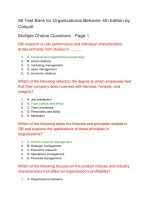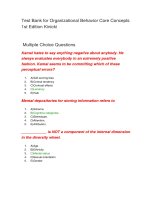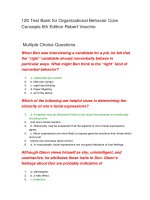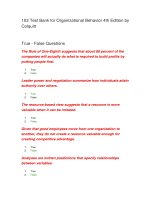Organizational behavior core concepts by kinicki chapter9
Bạn đang xem bản rút gọn của tài liệu. Xem và tải ngay bản đầy đủ của tài liệu tại đây (400.71 KB, 44 trang )
9
Organizational Behavior
core concepts
Communication: How to Get
Messages Across-Online and
Off
9-2
McGraw-Hill/Irwin
Organizational Behavior, Core Concepts
Copyright © 2008 by the McGraw-Hill Companies, Inc. All rights reserved.
Learning Objectives
• Describe the elements and steps of the
communication process
• Identify situations that can distort
communication between managers and
employees
• Contrast assertive, aggressive, and
nonassertive communication styles
9-3
Learning Objectives
• Discuss the skills of nonverbal
communication and effective listening
• Summarize how information technology
has affected communication in
organizations
• Give examples of barriers to effective
communication and ways to overcome
them
9-4
Dimensions of the
Communication Process
• Communication
– interpersonal exchange of information and
understanding
9-5
A Perceptual Model of Communication
9-6
Figure 9-1
Question?
What part of the communication process is
the output of encoding?
A. Sender
B. Feedback
C. Endless loop
D. Message
9-7
A Perceptual Process Model of
Communication
• Sender
– individual, group, or organization that
desires or attempts to communicate with a
particular receiver
• Encoding
– translates mental thoughts into code or
language that can be understood by others
9-8
A Perceptual Model of Communication
• Message
– output of encoding
– May contain hidden agendas as well as
trigger affective or emotional reactions
– Need to match the medium used to transmit
them
9-9
A Perceptual Model of Communication
• Selecting a Medium
– depends on the nature of the message, its
intended purpose, type of audience,
proximity to the audience, time horizon for
disseminating the message, personal
preferences, and the complexity of the
problem/situation at hand
9-10
A Perceptual Model of Communication
Potential Media:
• Face-to-face conversations
• Telephone calls
• Written memos or letters
9-11
A Perceptual Model of Communication
• Decoding
– consists of translating verbal, oral, or visual
aspects of a message into a form that can
be interpreted
• Creating meaning
– receiver creates the meaning of a message
in his head
• Feedback
9-12
– receives encodes a response and then
transmits it to the original sender
A Perceptual Model of Communication
• Noise
– interference with the transmission and
understanding of a message
9-13
Communication Distortion between
Managers and Employees
• Communication distortion
– purposely modifying the content of a
message, thus reducing the accuracy of
communication between managers and
employees
9-14
Interpersonal Communication
• Communication competence
– ability to effectively
use communication
behaviors in a given
context
9-15
Criteria Shaping Communication
Competence
9-16
Figure 9-2
Assertiveness, Aggressiveness,
and Nonassertiveness
• Assertive style
– expressive and self-enhancing, but does not
take advantage of others.
• Aggressive style
– expressive and self-enhancing, but takes
advantage of others
• Nonassertive style
– timid and self-denying behavior.
9-17
Communication Styles
9-18
Sources of Nonverbal
Communication
• Nonverbal Communication
– messages sent outside of the written and
spoken word
9-19
Sources of Nonverbal
Communication
•
•
•
•
9-20
Body movement and gestures
Touch
Facial expression
Eye contact
Improving Nonverbal
Communication Skills
Positive nonverbal actions include the
following:
– Maintain eye contact
– Nod to show interest and agreement
– Lean forward to show the speaker you are
interested
– Use a tone of voice that matches your
message
9-21
Improving Nonverbal
Communication Skills
Negative nonverbal actions include the
following:
– Avoiding eye contact and looking away from
the speaker
– Closing your eyes or tensing your facial
muscles
– Licking your lips
– Biting your nails
9-22
Active Listening
• Listening
– actively decoding and interpreting verbal
messages.
9-23
Question?
Which listening style integrates information
by focusing on relationships among
ideas?
A. Appreciative
B. Empathetic
C. Comprehensive
D. Discerning
9-24
Listening Styles
• Appreciative
– listens for pleasure, entertainment, or
inspiration
• Empathetic
– interprets messages by focusing on
emotions and body language
• Comprehensive
9-25
– organizes specific thoughts and actions and
integrates this information by focusing on
relationships among ideas









